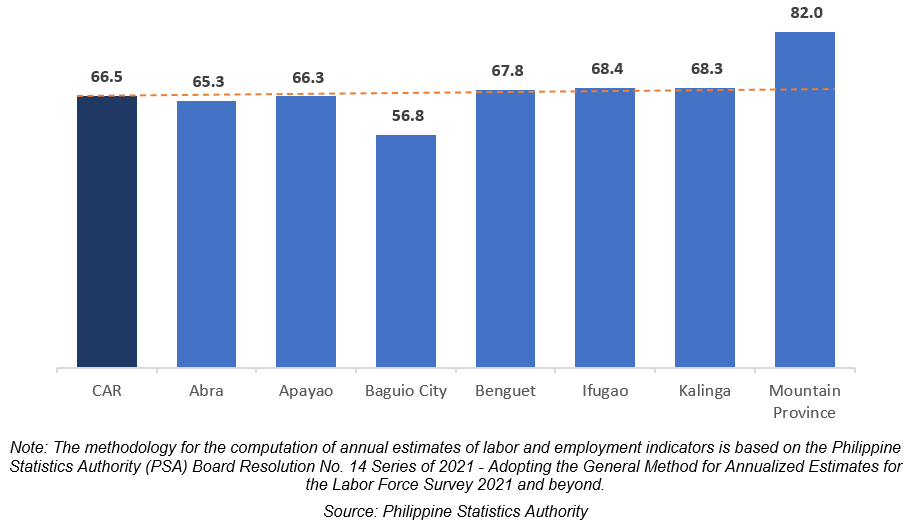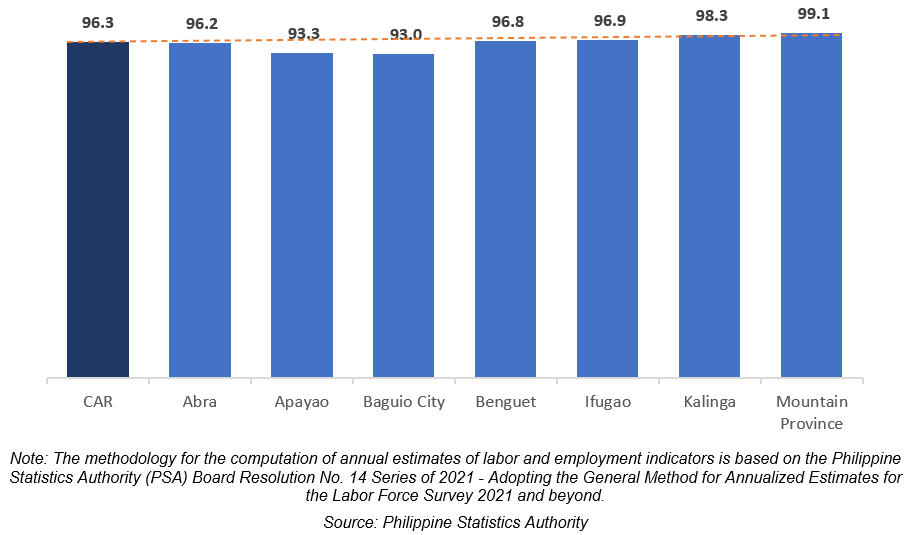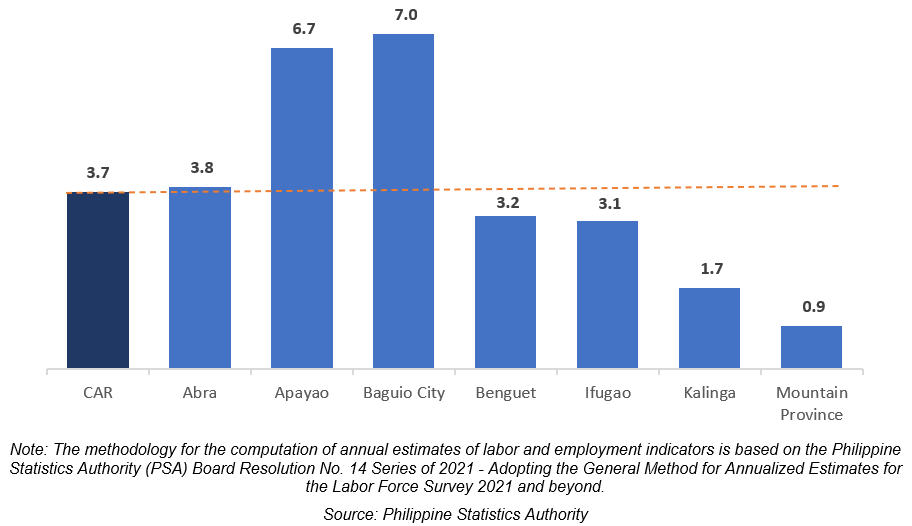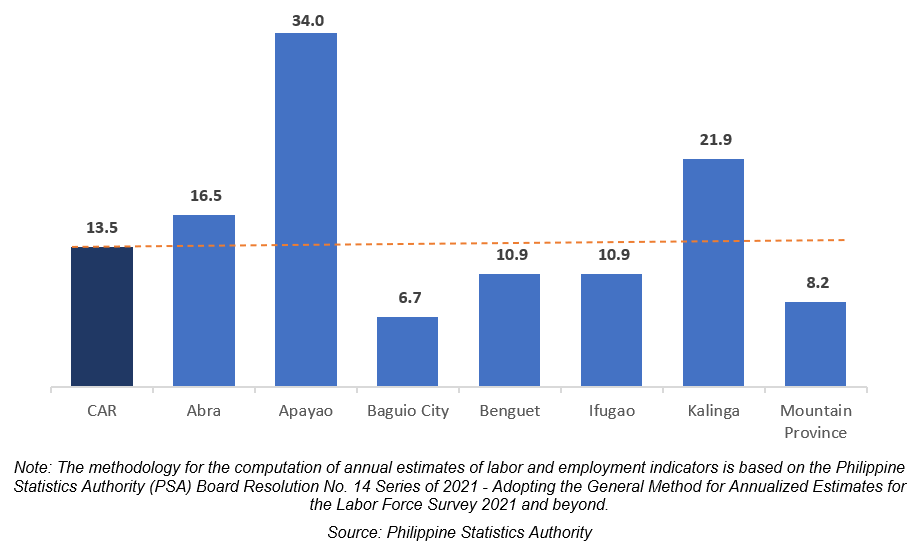The Labor Force Survey (LFS) gathers such data on the demographic and socio-economic characteristics of the population with nationwide coverage and conducted on a quarterly and monthly mode by interviewing households. It aims to provide a quantitative framework for the preparation of plans, and formulation of policies affecting the labor market.
Specifically, the survey is designed to provide statistics on levels and trends of employment, unemployment, and underemployment for the country, as a whole and for each of the administrative regions.
This Special Release discusses the labor force participation, employment, unemployment, and underemployment of the provinces in the Cordillera Administrative Region in 2022.
66.5% of population 15 years old and over are in the labor force
In 2022, about 842 thousand of the estimated 1.27 million population aged 15 years old and over in the Cordillera Administrative Region (CAR) were in the labor force. This resulted in a Labor Force Participation Rate (LFPR) of 66.5% or 665 in every 1000 of the population aged 15 years old and over were either employed or unemployed. This was 1.8 percentage points higher than the recorded LFPR of 64.7% in the country.
Across provinces, Mountain Province recorded the highest LFPR of 82.0% followed by Ifugao (68.4%), Kalinga (68.3%), and Benguet (67.8%). Moreover, these provinces recorded higher LFPR than the recorded regional LFPR.
On the other hand, the provinces of Apayao and Abra, and the City of Baguio recorded LFPR lower than the regional LFPR with 66.3%, 65.3% and 56.8%, respectively.
Figure 1. Labor Force Participation Rate (LFPR) by Province/HUC, CAR: 2022
(In Percent)

Mountain Province registers the highest employment rate
Of the recorded 842 thousand population aged 15 years old and over in the region who were in the labor force, 0.81 million or 96.3% were employed. The employment rate in the region was 1.7 percentage points higher than the employment rate of 94.6% in the country.
Among regions, CAR and SOCCSKSARGEN posted the highest employment rate both with 96.3%. This was followed by Cagayan Valley and Davao Region both with 96.0%. National Capital Region posted the lowest employment rate of 92.8%.
Among all provinces/HUCs across the country, Mountain Province registered the highest employment rate with 99.1% followed by Ilocos Norte and Kalinga with 98.9% and 98.3%, respectively. Tawi-Tawi registered the lowest employment rate with 90.3%.
In CAR, the provinces of Abra and Apayao, and the City of Baguio posted employment rates lower than regional employment rate with 96.2%, 93.3% and 93.0%, respectively.
Figure 2. Employment Rate by Province/HUC, CAR: 2022
(In Percent)

Meanwhile, the region recorded an unemployment rate of 3.7%. This was 1.7 percentage points lower than the national employment rate of 5.4%. The City of Baguio recorded the highest unemployment rate with 7.0% followed by Apayao (6.7%), Abra (3.8%), Benguet (3.2%), and Ifugao (3.1%). Mountain Province recorded the lowest unemployment rate of 0.9%.
Figure 3. Unemployment Rate by Province/HUC, CAR: 2022
(in Percent)

Underemployment reaches 13.5%
Of the estimated 0.81 million employed population aged 15 years old and over in the region, 13.5% were underemployed. Underemployed persons are those employed persons who express the desire to have additional hours of work in their present job or to have additional job or to have a new job with longer working hours.
Among provinces/HUC, Apayao registered the highest underemployment rate of 34.0%. This was followed by Kalinga and Abra with underemployment rates of 21.9% and 16.5%, respectively.
Meanwhile, three (3) provinces and one (1) HUC posted underemployment rates lower than the regional rate, namely, Benguet (10.9%), Ifugao (10.9%), Mountain Province (8.2%), and the City of Baguio (6.7%).
Figure 4. Underemployment Rate by Province/HUC, CAR: 2022
(In Percent)

(SGD)
VILLAFE P. ALIBUYOG
Regional Director
Designation Initials Date
CSS AFRBJ 30 January 2025
SSS WBM 20 January 2025
SA LMB 17 January 2025
Technical Notes
The Annual Labor Force Survey (LFS) refers to the average of data collected across all survey rounds throughout the year. It produces labor and employment statistics for the full year, providing a more comprehensive analysis of the Philippine labor market, including the regional, provincial, and highly urbanized city (HUC) levels.
a. Reference Period
The reference period for this survey is the “past week” referring to the past seven (7) days preceding the date of visit of the enumerator or the interviewer.
b. Employment Status Concepts
1. Population 15 Years Old and Over refers to the number of population 15 years old and over excluding overseas workers. Overseas workers are excluded in the estimation of the size of working population (population aged 15 years and over) since the data on their economic characteristics are not collected because they are not considered part of the labor force in the country.
2. In the Labor Force or Economically Active Population refers to persons 15 years old and over who are either employed or unemployed in accordance with the definitions described below.
3. Employed persons include all those who, during the reference period, are 15 years old and over as of their last birthday, and are reported either:
a. At work, i.e., those who do any work even for one hour during the reference period for pay or profit, or work without pay on the farm or business enterprise operated by a member of the same household related by blood, marriage, or adoption; or
b. With a job but not at work, i.e., those who have a job or business but are not at work because of temporary illness or injury, vacation, or other reasons. Likewise, persons who expect to report for work or to start operation of a farm or business enterprise within two weeks from the date of the enumerator’s visit are considered employed.
4. Underemployed persons include all employed persons who express the desire to have additional hours of work in their present job, or an additional job, or to have a new job with longer working hours. Visibly underemployed persons are those who work for less than 40 hours during the reference period and want additional hours of work.
5. Unemployed
Starting April 2005, the new unemployment definition was adopted per NSCB Resolution Number 15 dated 20 October 2004. As indicated in the said resolution:
Unemployed persons include all those who, during the reference period, are 15 years old and over ad of their last birthday, and are reported as persons:
a. Without work, i.e., had no job or business during the reference period;
b. Currently available for work, i.e., were available and willing to take up work in paid employment or self-employment during the reference period, and/or would be available and willing to take up work in paid employment or self-employment within two weeks after the interview date; and
c. Seeking work, i.e., had taken specific steps to look for a job or establish a business during the reference period, or
d. Not seeking work due to the following reasons: (1) fatigued or believed no work available, i.e., discouraged workers; (2) waiting for the results of previous job application; (3) temporary illness or disability; (4) bad weather; and/or (5) waiting for rehire or job recall.
6. Persons Not in the Labor Force refers to persons 15 years old and over who were neither employed nor unemployed according to the definitions mentioned. Those not in the labor force are persons who are not looking for work because of reasons such as housekeeping, schooling, and permanent disability. Examples are housewives, students, persons with disability, or retired persons.

